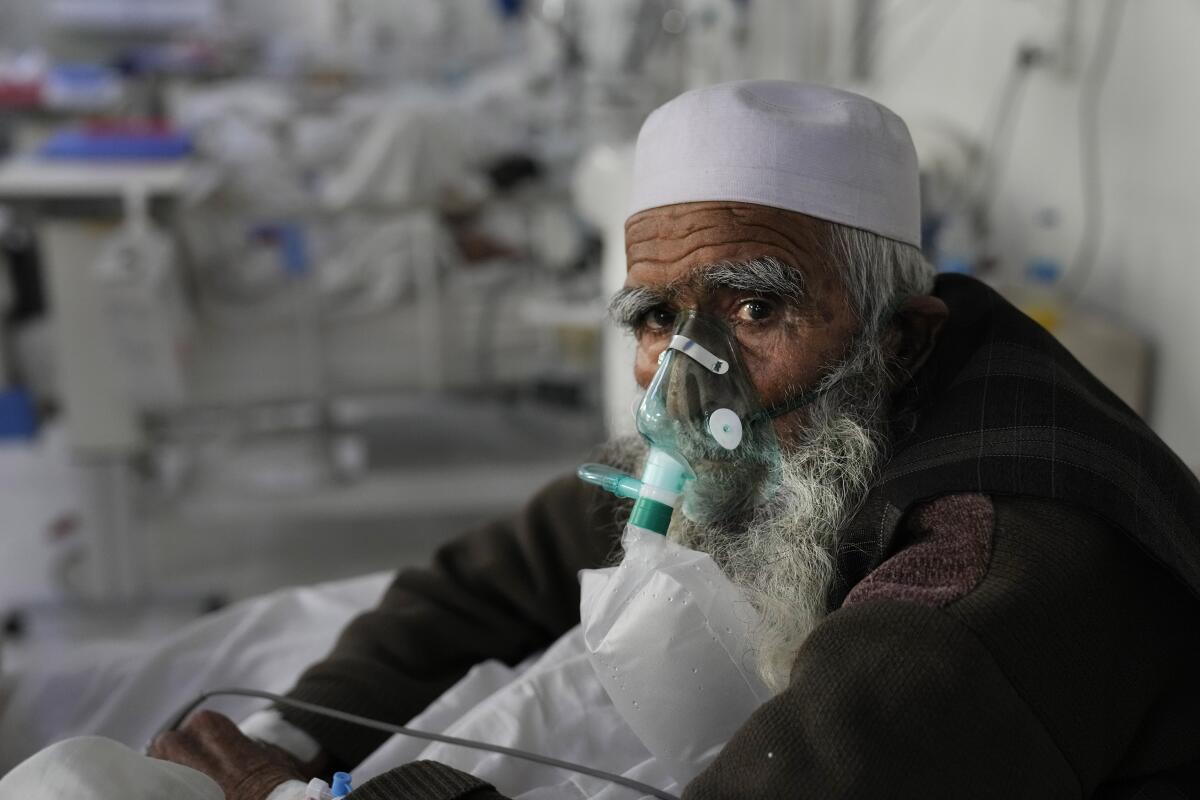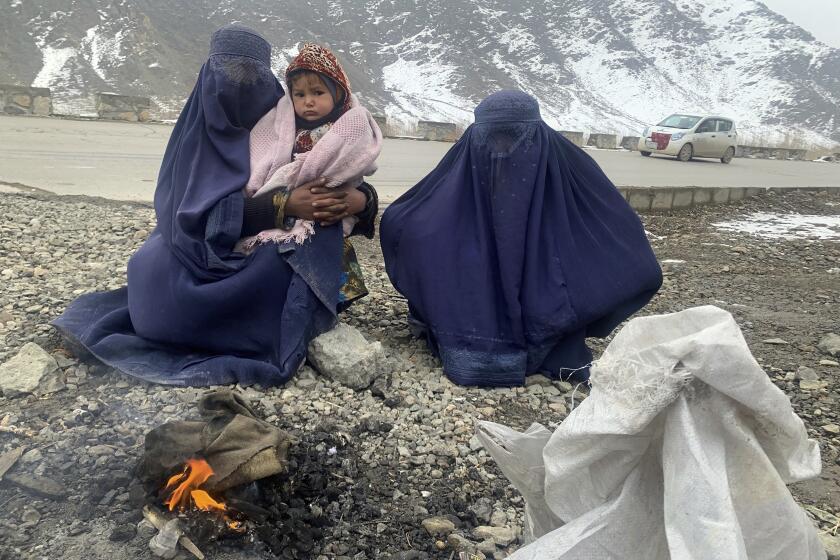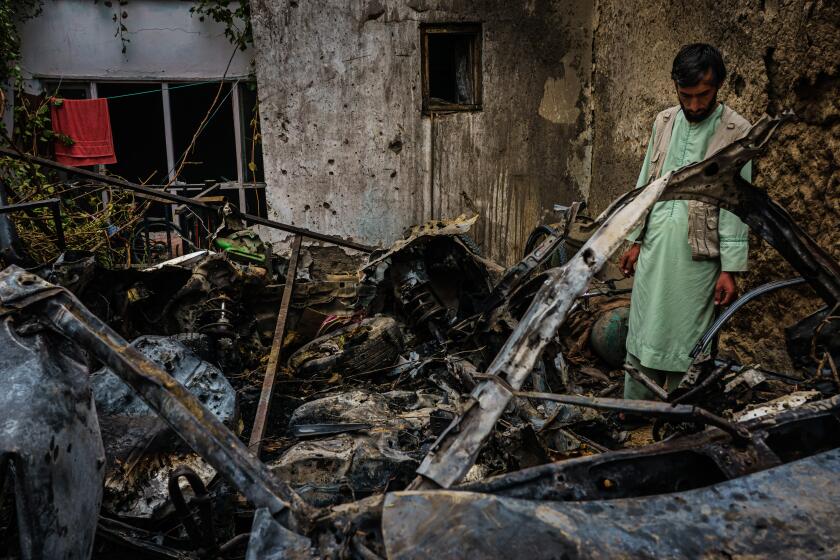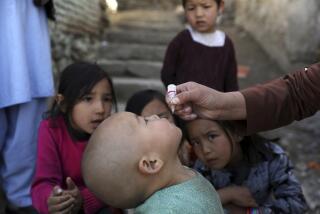A new COVID wave batters Afghanistan’s crumbling healthcare system

- Share via
KABUL, Afghanistan — Only five hospitals in Afghanistan still offer COVID-19 treatment, with 33 others having been forced to close in recent months for lack of doctors, medicines and even heat. This comes as the economically devastated nation is hit by a steep rise in the number of reported coronavirus cases.
At Kabul’s only COVID-19 treatment hospital, staff can heat the building only at night because of lack of fuel, even as winter temperatures drop below freezing during the day. Patients are bundled under heavy blankets. The hospital’s director, Dr. Mohammed Gul Liwal, said they need everything from oxygen to medicine supplies.
The facility, called the Afghan Japan Communicable Disease Hospital, has 100 beds. The COVID-19 ward is almost always full as the coronavirus rages. Before late January, the hospital was getting one or two new COVID-19 patients a day. In the past two weeks, 10 to 12 new patients have been admitted daily, Liwal said.
“The situation is worsening day by day,” said Liwal, speaking inside a chilly conference room. Since the Taliban returned to power in August, hospital employees have received only one month’s salary, in December.
Afghanistan’s healthcare system, which survived for nearly two decades almost entirely on international donor funding, has been devastated since the Taliban’s takeover following the chaotic end to the 20-year U.S.-led intervention. Afghanistan’s economy crashed after nearly $10 billion in assets abroad was frozen and financial aid to the government was largely halted.
The healthcare system’s collapse has only worsened the humanitarian crisis in the country. Roughly 90% of the population has fallen below the poverty level, and with families barely able to afford food, at least 1 million children are threatened with starvation.
Afghanistan’s bitter winter cold has international aid organizations scrambling to try to help millions of people who have neither food nor fuel.
The Omicron variant of the coronavirus is hitting Afghanistan hard, Liwal said, but he admits it’s just a guess because the country is still waiting for kits that test specifically for the variant. They were supposed to arrive before the end of last month, said Public Health Ministry spokesman Dr. Javid Hazhir. The World Health Organization now says Afghanistan will get the kits by the end of this month.
The WHO says that, between Jan. 30 and Feb. 5, public laboratories in Afghanistan tested 8,496 samples, of which nearly half were positive for COVID-19. Those numbers translate into a 47.4% positivity rate, the world health body said.
As of Tuesday, the WHO recorded 7,442 deaths and close to 167,000 infections in Afghanistan since the start of the pandemic almost two years ago. In the absence of large-scale testing, these relatively low figures are believed to be a result of extreme underreporting.
Meanwhile, the new Taliban administration says it is trying to push COVID-19 vaccines on a skeptical population that often sees them as dangerous.
The survivors of an errant drone strike in Kabul that killed 10 members of their family are frustrated no U.S. troops will face disciplinary action.
With 3.2 million vaccine doses in stock, Hazhir said the government has launched a campaign through mosques, clerics and mobile vaccine clinics to get more people inoculated. Currently, barely 27% of Afghanistan’s 38 million people have been vaccinated, most with the single-dose Johnson and Johnson vaccine.
Getting Afghans to follow even a minimum of safety protocols, such as mask-wearing and social distancing, has been near-impossible, Liwal said. For many struggling to feed their families, COVID-19 ranks low on their list of fears, he said. The Public Health Ministry has run awareness campaigns about the value of masks and social distancing, but most people aren’t listening.
Even in the Afghan Japan hospital, where signs warn people that mask-wearing is mandatory, most people in the dimly lit halls were without them. In the intensive care unit, where half of the 10 patients in the ward were on ventilators, doctors and attendants wore only surgical masks and gowns for protection as they moved from bed to bed.
The head of the unit, Dr. Naeemullah, said he needs more ventilators and, even more urgently, more doctors trained in using ventilators. He is overstretched and rarely paid, but feels duty-bound to serve his patients. Liwal said several doctors have left Afghanistan.
News Alerts
Get breaking news, investigations, analysis and more signature journalism from the Los Angeles Times in your inbox.
You may occasionally receive promotional content from the Los Angeles Times.
Most of the hospital’s 200 employees come to work regularly despite months without pay.
In December, a U.S.-based charity affiliated with Johns Hopkins University provided two months’ funding, which gave the hospital staff members their December salary and a promise of another paycheck in January. The Public Health Ministry is now in negotiations with the WHO to take over the cost of running the hospital through June, said Liwal.
Liwal said other Kabul hospitals used to be able to take some patients, but now no longer have the resources. With a lack of funds and the departure of staff, 33 facilities offering COVID-19 treatment nationwide have shut down, he said.
The Afghan Japan hospital’s only microbiologist, Dr. Faridullah Qazizada, earned less than $1,000 a month before the Taliban took power. He has received only one month’s salary since August, he said, adding that his equipment and facilities are barely adequate.
“The whole health system has been destroyed,” he said.
More to Read
Sign up for Essential California
The most important California stories and recommendations in your inbox every morning.
You may occasionally receive promotional content from the Los Angeles Times.












